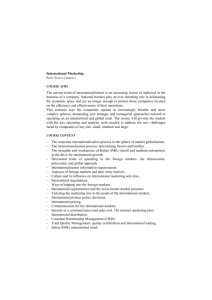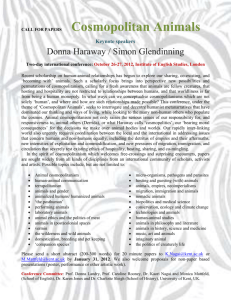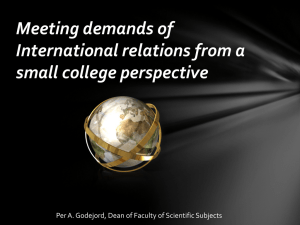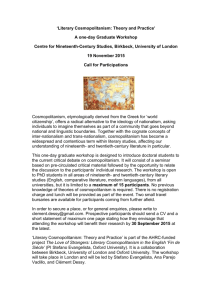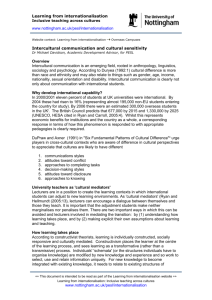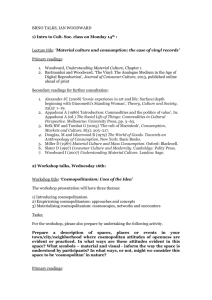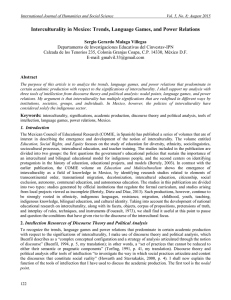Sample presentation for Academic Integrity Officers
advertisement
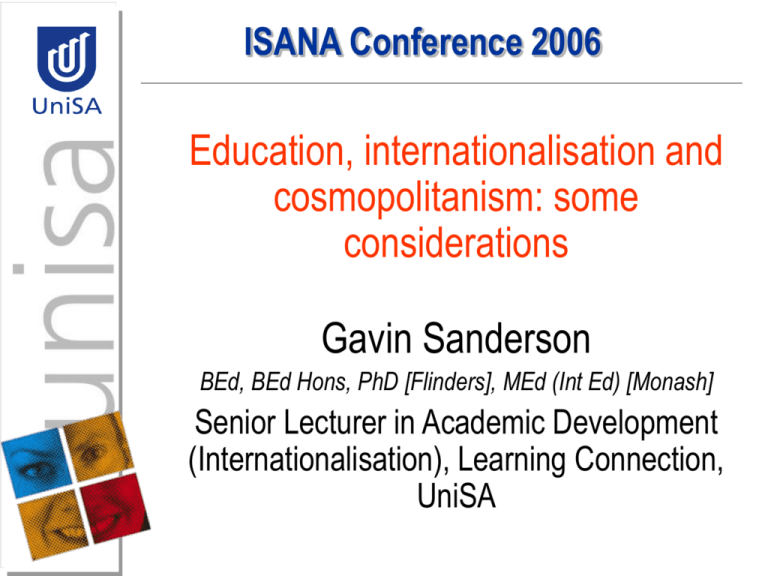
ISANA Conference 2006 Education, internationalisation and cosmopolitanism: some considerations Gavin Sanderson BEd, BEd Hons, PhD [Flinders], MEd (Int Ed) [Monash] Senior Lecturer in Academic Development (Internationalisation), Learning Connection, UniSA Today’s schedule 1/ John Biggs’s (2003) three levels of teaching. 2/ Towards a cosmopolitan outlook. The inward journey of personal discovery and the outward journey of discovering others. What is internationalisation? “The process of integrating an international, intercultural, or global dimension into the purpose, functions or delivery of post-secondary education” (Knight, 2004, p. 11) Figure 1 The depth & breadth dimensions of the reach of internationalisation in Knight’s (2004) definition National level Intercultural, international, and global flows of technology, economy, knowledge, people, values, and ideas Sector level Institution level Breadth dimension of the reach of internationalisation Source. Sanderson, 2006, p. 149 Depth dimension of the reach of internationalisation Figure 2 The true extent of the depth dimension of the reach of internationalisation (Source. Sanderson, 2006, p. 149) Global level Supranational level Regional level Intercultural, international, and global flows of technology, economy, knowledge, people, values and ideas National level Sector level Institution level Faculty/Department level Within-institution level Individual level Breadth dimension of the reach of internationalisation Depth dimension of the reach of internationalisation Limits of Knight’s (2004) depth dimension The Profile and its qualifications Q1: General. Q2: Issues related to using a non-native language of instruction. 66% of Profile’s Q3: Factors related to dealing with cultural criteria differences. Q4: Specific requirements regarding teaching and learning styles. Q5: Using media and technology. Q6: Specific requirements connected with the academic discipline and diploma recognition. Q7: Knowledge of foreign education systems. Q8: Knowledge of the international labour market. Q9: Personal qualities. The international classroom Teaching approaches and strategies which are traditionally driven by national perspectives and needs might no longer be wholly sufficient for the novel teaching and learning environment of the international classroom. (Teekens, 2000, p. 5) John Biggs – the fly in the ointment? Figure 3 The focus in cross-cultural teaching (Source. Biggs, 2003, p. 124) Level 1 teaching: assimilate Based on stereotypes What are the stereotypes of international students? (… and Australian students?) Learning problems attributed to students Students must assimilate into the local system ▼ A deficit model of education Figure 4 The ‘typical’ Australian male (Source. Mezger, 1992, p. 22) Level 2 teaching: accommodate Based on the teacher adjusting to the characteristics of the students ▼ ‘Multi-grid reference ► curricula’ ▼ Teachers have culturespecific knowledge Minor-to-radical adjustments to curricula ▼ A deficit model of education Level 3 teaching: educate Based on the teacher meeting the learning needs of the students ▼ Curricula are ‘constructively aligned’ ▼ The only justifiable approach to teaching students Biggs (2003) says “ethnicity is beside the point” (p. 134). ▼ “Teach better, and you’ll address the problems presented by ISs [international students]” (p. 138). Level 3 teaching: educate Figure 5 Explaining social taboos (Source. Mezger, 1992, p. 37) But what about … “Teaching with an awareness of cultural diversity is simply good teaching” (Prosser and Trigwell, 1998, p. 170). What to do lah? Figure 6 Country index scores for Hofstede’s cultural dimensions (Source. ITIM Culture & Management Consultants, 2003) Table 1 Key differences in schooling between low & high PDI societies (Source. Hofstede, 2001, p. 107). Australia (Low PDI) Malaysia (High PDI) Teachers treat students as Students depend on equals teachers Students treat teachers as Students treat teachers equals with respect, even outside class Student-centred education Teacher-centred education Students initiate some communication in class Teachers initiate all communication in class Teachers are experts who transfer impersonal truths Teachers are gurus who transfer personal wisdom Examples of suitable teaching strategies Inculcate students into Australian academic culture; Establish names (including pronunciation) early in the semester; Provide opportunities for students to use their English writing skills for non-assessment tasks; Provide explicit expectations about assessment; Provide clear instructions for oral presentations; Provide opportunities for success. For example, allow students time to discuss issues in pairs or small groups before speaking to the whole group; Use a staged assessment schedule to enable students to build skills. But are these just for international students? Inculcate students into Australian academic culture; Establish names (including pronunciation) early in the semester; Provide opportunities for students to use their English writing skills for non-assessment tasks; Provide explicit expectations about assessment; Provide clear instructions for oral presentations; Provide opportunities for success. For example, allow students time to discuss issues in pairs or small groups before speaking to the whole group; Use a staged assessment schedule to enable students to build skills. Level 3 teaching Is it possible to make ‘culture’ invisible in the classroom from the point of view of a strict interpretation of teaching? Do good teachers look beyond stereotypes? Interculturality – perhaps the best practical and achievable outcome for those wanting to aspire to Biggs’s (2003) Level 3 teaching. What are we talking about? Cross-cultural? Multicultural? Intercultural? Interculturality is primarily concerned with “issues of identity and engagement” and contains both a “culture-general (and) culture-specific component” (Liddicoat, 2003, p. 19). Interculturality Begins with knowing yourself (culture-general enquiry): “Before we can recognize the ‘Other’, we have to know ourselves well” (Stromquist, 2002, p. 93). “Only when we have clearly defined our own person and identity are we able to understand other identities” (Breuer, 2002, p. 15). Interculturality “A degree of confident self awareness is not necessarily to be seen as a conservative force in society. It can be a pre-condition for a sustained program of social or economic revival” (Milner, 1996, p. 17). “Respect for the other presupposes that a person has considerable selfawareness” (Djebar, 2002, p. 229). Interculturality “If one is to understand others, one must first understand oneself” (International Commission on Education for the Twenty-First Century, 1996, p. 93). “Harmony with others depends on knowing ourselves and our cultures” (Pedersen, 1988, p. 74). Interculturality “The best thing we can do for our relationships with others … is to render our relationship to ourselves more conscious” (Hollis, as cited in Cranton, 2001, p. 74). “In order to learn about another culture, we need to learn about our own” (McLaughlin & Liddicoat, 2005, p. 6). Interculturality … and the exhortation from Socrates to know thyself… Cosmopolitanism Whilst considerations of ethnicity are ‘beside the point’ in teaching international students at Level 3 teaching, it can be argued that the teachers are ultimately comfortable with cultural difference. They have good intercultural sensibilities. Compared to Level 1 teachers, they exhibit a cosmopolitan disposition. A cosmopolitan outlook I am a citizen of the world – Diogenes (around 350BC) Definition of ‘cosmopolitan’ “Belonging to, or representative of, all parts of the world … Free of national prejudices; international in experience or outlook” (Manser & Thompson, 1995, p. 289). “belief in a cosmopolitan outlook” (Manser & Thompson, 1995, p. 289). Cosmopolitanism “Feeling at home in the world” (Gunesch, 2004, p. 256). “An intellectual and aesthetic sense of openness towards people, places and experiences from different cultures, especially those from different nations” (Tomlinson, as cited in Matthews & Sidhu, 2005). Cosmopolitanism Grounded, or rooted, cosmopolitanism. “the global me: local people who are neither limited to their particularities nor doomed to an empty we-are-theworld universalism” (G. Pascal Zachary, 2000, p. xv). References Biggs, J. (2003). Teaching for quality learning at university (2nd ed.). Maidenhead: Open University Press. Breuer, R. (2002). Freedom’s twin. In S. Stern & E. Seligmann (Eds.), The end of tolerance? (pp. 11-16). London: Nicholas Brearley Publishing. Cranton, P. (2001). Becoming an authentic teacher in higher education. Malabar: Krieger Publishing Company. Djebar, A. (2002). Return to Islamic roots? In S. Stern & E. Seligmann (Eds.), The end of tolerance? (pp. 228-232). London: Nicholas Brearley Publishing. G. Pascal Zachary. (2000). The global me: why nations will succeed or fail in the next generation. St Leanords: Allen & Unwin. Gunesch, K. (2004). Education for cosmopolitanism? Cosmopolitanism as a personal cultural identity model for and within international education. Journal of Research in International Education, 3(3), 251-275. Hofstede, G. (2001). Cultural consequences: comparing values, behaviors, institutions and organizations across nations (2nd ed.). Thousand Oaks: Sage Publications References (cont) International Commission on Education for the Twenty-First Century. (1996). Learning: The treasure within: report to UNESCO of the International Commission on Education for the Twenty-First Century. Paris: UNESCO Publishing. ITIM Culture & Management Consultants. (2003). Compare your home culture with your host culture. Retrieved 3 May, 2005, from http://www.geert-hofstede.com/hofstede_dimensions.php? Knight, J. (2004). Internationalization remodelled: definition, approaches, and rationales. Journal of Studies in International Education, 8(1), 5-31. Liddicoat, A. (2003). Internationalisation as a concept in higher education: perspectives from policy. In A. Liddicoat, S. Eisenchlas & S. Trevaskes (Eds.), Australian perspectives on internationalising education (pp. 13-26). Melbourne: Language Australia Ltd. McLaughlin, M., & Liddicoat, T. (2005). Teachers’ professional learning in the context of intercultural language learning. Babel, 40(1), 4-12, 38. Manser, M., & Thomson, M. (Eds.). (1995). Chambers combined dictionary thesaurus. Edinburgh: Chambers. Matthews, J., & Sidhu, R. (2005). Desperately seeking the global subject: international education, citizenship and cosmopolitanism. Globalisation, Societies and Education, 3(1), 49-66. References (cont) Mezger, J. (1992). Bridging the intercultural communication gap: a guide for TAFE teachers of international students (2nd ed.). Hobart: National TAFE Overseas Network. Milner, A. (1996). Defining Australia in Asia. In G. E. Jones (Ed.), Cunningham Lecture and Symposium 1995: Australia in its Asian context (Vol. Occasional Paper Series 1/1996). Canberra: Academy of Social Sciences in Australia. Pedersen, P. (1988). A handbook for developing multicultural awareness. Alexandria: American Association for Counseling and Development. Prosser, M., & Trigwell, K. (1998). Teaching in higher education. In B. Dart & G. Boulton-Lewis (Eds.), Teaching and learning in higher education (pp. 250-268). Camberwell: ACER Press. Sanderson, G. (2006). Examination of a profile of the ideal lecturer for teaching international students. Adelaide: Flinders University. Stromquist, N. (2002). Globalization, the I, and the Other. Retrieved May 29, 2003, from http://www.tc.columbia.edu/CICE/articles/nps142.htm Teekens, H. (2000). Introduction. In H. Teekens (Ed.), Teaching and learning in the international classroom (pp. 5-7). The Hague: Netherlands Organization for International Cooperation in Higher Education (NUFFIC)
